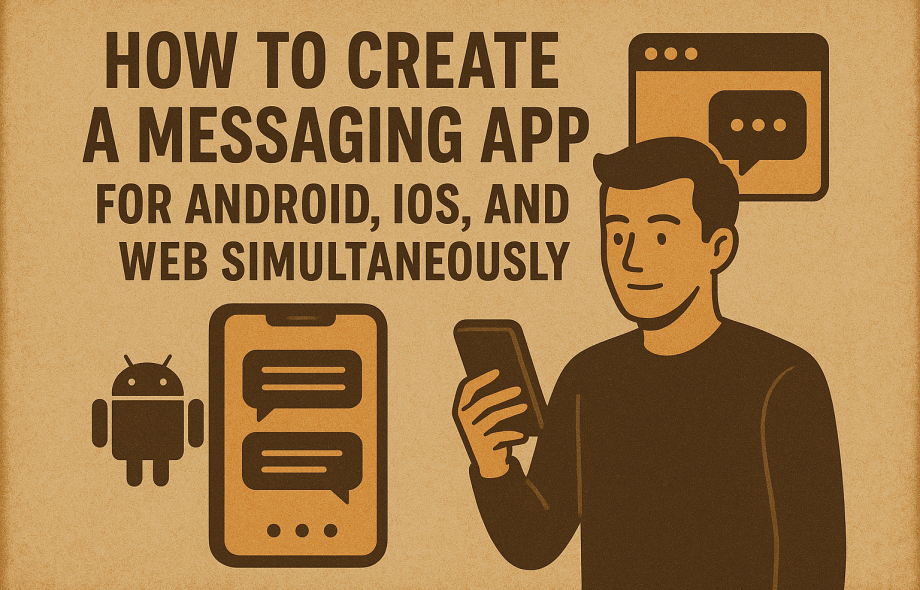In today’s hyper-connected world, messaging apps have become an essential part of how we communicate, collaborate, and share information. From personal conversations to business communication, users expect instant, seamless, and secure interaction — no matter what device they’re using. As a result, developers and businesses alike are focusing on Messaging App Development that works flawlessly across Android, iOS, and web platforms simultaneously.
But how can you actually build a messaging app that delivers consistent performance and user experience across all three? Let’s explore the process, technologies, and strategies that go into creating a cross-platform messaging application that rivals the best in the industry.
1. Understanding the Goal of Cross-Platform Messaging
Before jumping into development, it’s important to understand the goal: to create a messaging app that feels native on every platform but is powered by a shared codebase. Cross-platform development not only reduces time and cost but also ensures that updates, fixes, and new features can be rolled out seamlessly to all users.
This approach allows developers to focus more on innovation — integrating real-time communication, voice and video calls, and AI-driven features — rather than maintaining separate codebases for Android, iOS, and web.
In short, cross-platform Messaging App Development services ensures maximum reach with minimum redundancy.
2. Choosing the Right Tech Stack
The foundation of any great messaging app lies in the technology stack. For multi-platform apps, developers need tools and frameworks that can handle scalability, real-time performance, and smooth synchronization.
Here’s a breakdown of the ideal tech stack for Android, iOS, and web:
Frontend (Client-Side)
Frameworks: Flutter, React Native, or Ionic
Web Interface: React.js or Angular
UI Design: Responsive layout systems (Material Design or Cupertino for iOS themes)
Communication Protocol: WebSocket for real-time messaging
Backend (Server-Side)
Programming Languages: Node.js, Python, or Go
Frameworks: Express.js, Django, or FastAPI
Database: Firebase Realtime Database, MongoDB, or PostgreSQL
Authentication: OAuth 2.0 or Firebase Auth
Cloud Hosting: AWS, Google Cloud, or Azure
Real-Time Communication
For instant delivery, WebSocket or MQTT protocols are ideal since they maintain a continuous connection between client and server, enabling instant message exchange.
3. Designing the App Architecture
A well-planned architecture is key to building a scalable and reliable messaging app. The app should be modular, with each component managing a specific function — such as messaging, notifications, media sharing, or authentication.
A recommended architecture includes:
Client Layer: Handles UI and user interactions.
Backend Layer: Manages message routing, authentication, and storage.
Database Layer: Stores messages, media files, and user data.
API Layer: Enables communication between client and backend.
Additionally, adopting a microservices architecture allows developers to update individual modules without affecting the entire system — perfect for large-scale applications.
4. Core Features Your Messaging App Must Have
When building a modern messaging app, the features you include determine both user satisfaction and retention. Here are the must-have features:
Real-Time Messaging: Instant text, image, video, and file exchange.
Group Chats: Let users create private or public groups.
Voice & Video Calls: High-quality real-time communication.
Push Notifications: Keep users informed about new messages instantly.
Media Sharing: Support for GIFs, photos, videos, and documents.
Message Status Indicators: Delivered, read, and typing status.
End-to-End Encryption: To protect user privacy.
Offline Mode: Sync messages once users are back online.
User Presence Tracking: Show online/offline status.
Search & Filters: For easy content navigation.
Each of these features should be optimized for performance and battery efficiency — especially on mobile devices.
5. Step-by-Step Guide to Building Your Messaging App
Step 1: Define Your App’s Purpose
Decide whether your app will target individuals, enterprises, or niche communities. This will guide feature prioritization and monetization strategies.
Step 2: Wireframe and Design
Create wireframes to map out user flows. Use tools like Figma or Sketch to design clean and intuitive interfaces that feel native across platforms.
Step 3: Choose the Framework
Flutter and React Native are the most popular frameworks for cross-platform messaging apps. Flutter provides near-native performance, while React Native offers flexibility and strong community support.
Step 4: Set Up Backend Infrastructure
Choose a reliable backend that supports real-time messaging and scalability. Firebase or AWS Amplify are great choices for startups because they simplify authentication and database management.
Step 5: Implement Real-Time Messaging
Use WebSockets for real-time communication. This allows messages to be delivered instantly without frequent HTTP requests.
Step 6: Integrate Push Notifications
Use Firebase Cloud Messaging (FCM) or Apple Push Notification Service (APNS) for timely message delivery.
Step 7: Add Security Features
Implement end-to-end encryption using cryptographic libraries. Ensure secure login and data transmission to protect users’ information.
Step 8: Test Across Platforms
Perform rigorous testing on Android, iOS, and various browsers to ensure consistent performance. Tools like BrowserStack or Appium can automate cross-platform testing.
Step 9: Launch and Monitor
After deployment, use analytics tools to track engagement, crashes, and performance. Regular updates are key to keeping your users satisfied.
6. Ensuring Security and Compliance
Security is the cornerstone of any messaging app. Users expect their data and conversations to remain private. Implementing features such as end-to-end encryption, secure authentication, and two-factor login ensures compliance with global standards like GDPR.
In addition, developers must handle data responsibly — encrypting messages both in transit and at rest. Regular security audits and penetration tests help identify vulnerabilities early.
7. Why You Should Work with a Professional Development Partner
Creating a scalable, real-time messaging app for multiple platforms is complex. Partnering with a specialized Messaging App Development Company can significantly simplify the process. Professional developers bring experience in UI/UX, backend scalability, and cloud infrastructure.
They also offer end-to-end Messaging App Development Services, from ideation and design to deployment and post-launch support. This ensures that your app performs seamlessly across all devices while maintaining reliability and security.
8. Lessons from Industry Leaders
If you want to understand what it takes to build an app like WhatsApp, studying the success of leading platforms is essential. WhatsApp revolutionized messaging by focusing on simplicity, speed, and reliability.
The app’s success comes from its lightweight architecture, robust encryption, and ability to work efficiently even on slow networks. By learning from such proven design principles, developers can create apps that users love and trust.
9. Cost and Timeline Considerations
The cost of developing a cross-platform messaging app varies depending on complexity, features, and team size. A simple MVP may cost around $20,000–$50,000, while a fully-featured solution with real-time communication and AI integration can range between $80,000–$200,000.
The development timeline usually spans 3–6 months, depending on design iterations and testing requirements. Investing in quality code and secure infrastructure ensures long-term scalability and reduced maintenance costs.
10. The Future of Messaging App Development
Looking ahead, the messaging app industry will be driven by AI, AR integration, and enhanced personalization. Chatbots, smart replies, and voice assistants will make communication faster and more intuitive.
Moreover, decentralized technologies and blockchain will give users more control over their data. For developers, the challenge will be to balance innovation, privacy, and user experience in a constantly evolving ecosystem.
Conclusion
Building a cross-platform messaging app for Android, iOS, and web simultaneously is no longer just a technical challenge — it’s a strategic opportunity. By leveraging modern frameworks, cloud infrastructure, and secure communication protocols, you can deliver an app that feels natural on every device.
Whether you’re a startup, enterprise, or developer, the key lies in creating a platform that prioritizes user experience, scalability, and trust. The messaging apps of the future won’t just connect people — they’ll build communities, drive collaboration, and redefine digital communication.


 :
: